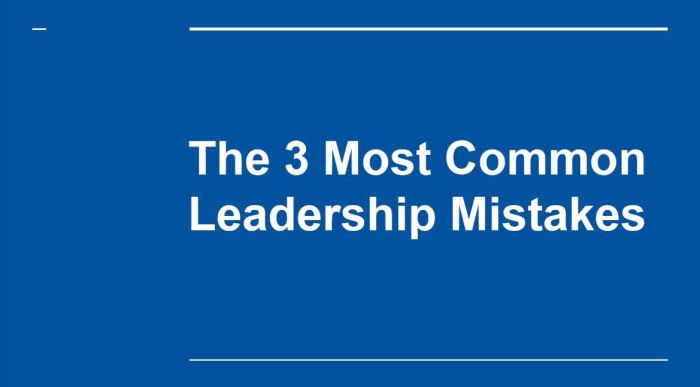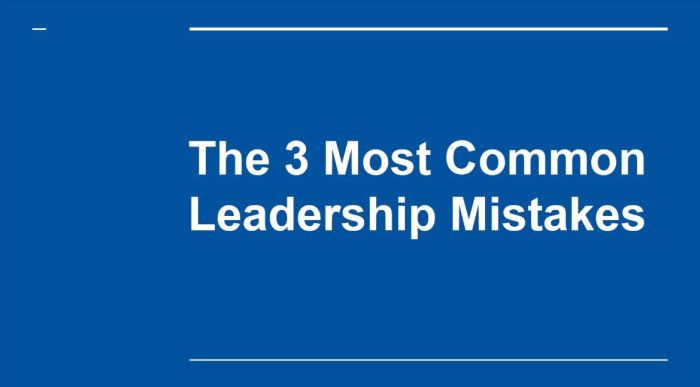
Sales manager leadership mistakes sets the stage for a critical examination of common pitfalls in sales management. From communication breakdowns to motivational missteps, these errors can significantly impact team performance, sales figures, and employee morale. This exploration delves into the various types of leadership blunders, examining their causes and consequences.
This article will dissect nine key areas of sales leadership, from effective communication and delegation to performance management, conflict resolution, building a strong team culture, adaptability, and leading diverse teams. We’ll analyze the common mistakes made in each area and provide practical strategies for avoiding them.
Defining Sales Manager Leadership Mistakes
Sales management is a complex role requiring a delicate balance of strategy, motivation, and communication. Effective leadership is crucial for driving team performance and achieving sales targets. However, sales managers, despite their best intentions, often make mistakes that can significantly impact their teams and company outcomes. Understanding these common pitfalls is the first step towards improvement and creating a high-performing sales organization.Sales manager leadership mistakes encompass a wide range of errors in managing people, motivating teams, and effectively communicating expectations.
These errors can range from neglecting individual needs to mismanaging performance reviews, and from poor communication strategies to a lack of clear sales strategies. The consequences of these mistakes can be far-reaching, impacting not only individual team members but also overall sales figures and company morale.
Common Types of Sales Manager Leadership Mistakes
A sales manager’s success hinges on their ability to create a positive and productive work environment. Common mistakes often stem from neglecting crucial aspects of effective leadership. These can include issues with communication, poor delegation, inadequate training, and insufficient support for team members.
Communication Failures
Poor communication can lead to misunderstandings, frustration, and decreased productivity. Sales managers may struggle to clearly articulate expectations, provide constructive feedback, or listen effectively to team members. Inconsistent communication, lack of transparency, and neglecting to address concerns promptly contribute to a negative work environment.
Inadequate Training and Development
Failing to provide adequate training and development opportunities for sales representatives hinders their growth and potential. This can result in underperformance, missed targets, and a lack of confidence. A lack of resources or mentorship can also lead to employee frustration and attrition.
Insufficient Support and Recognition
Sales managers who fail to offer sufficient support to their teams, or fail to acknowledge and recognize their achievements, are likely to face reduced motivation and decreased productivity. Ignoring individual challenges or not celebrating successes can create a demoralized team and limit individual potential.
Ineffective Delegation and Empowerment
Effective delegation is essential for leveraging team members’ strengths and promoting ownership. Managers who struggle to delegate tasks effectively, or fail to empower team members to take ownership of their work, can hinder productivity and growth. This can result in burnout, stress, and a lack of initiative within the team.
Lack of Clear Sales Strategy and Vision
Without a clear sales strategy and vision, sales teams may lack direction and focus. This can lead to inconsistent performance, missed targets, and a lack of motivation. Failing to provide a compelling vision, or to clearly Artikel the path towards achieving goals, can hinder team morale and productivity.
Performance Management Issues
Effective performance management is crucial for aligning individual efforts with overall sales objectives. Managers who fail to provide regular feedback, set clear expectations, or conduct effective performance reviews create ambiguity and hinder growth. Inconsistencies in evaluations, lack of accountability, and a lack of constructive feedback negatively impact team morale and productivity.
Table of Sales Manager Leadership Mistakes and Consequences
| Type of Mistake | Potential Consequences |
|---|---|
| Poor Communication | Misunderstandings, frustration, decreased productivity, low morale |
| Inadequate Training | Underperformance, missed targets, low confidence, increased employee turnover |
| Insufficient Support | Low motivation, decreased productivity, demoralized team, reduced initiative |
| Ineffective Delegation | Reduced productivity, lack of ownership, burnout, stress |
| Lack of Clear Sales Strategy | Inconsistent performance, missed targets, low motivation, lack of focus |
| Performance Management Issues | Ambiguity, hindered growth, low morale, lack of accountability |
Common Mistakes in Communication
Effective communication is the lifeblood of any successful sales team. A sales manager who struggles with clear, consistent, and empathetic communication risks demotivating their team, hindering productivity, and ultimately, impacting overall sales performance. Poor communication can lead to misunderstandings, misinterpretations, and a general feeling of disconnect among team members, creating a less productive and more stressful work environment.
Understanding these pitfalls is crucial for sales managers to foster a positive and high-performing team.Poor communication is a pervasive problem in sales management. It often manifests in a lack of clarity in expectations, inconsistent feedback, and a failure to actively listen to team members’ concerns. This lack of effective communication can result in team members feeling undervalued, unheard, and ultimately, unmotivated to achieve their full potential.
The impact on productivity is undeniable; when communication breaks down, so does the flow of information, ideas, and collaboration, directly impacting the team’s ability to hit sales targets.
Communication Pitfalls in Sales Management
Poor communication in sales management manifests in several key areas. A lack of clarity in expectations creates ambiguity, hindering the team’s ability to focus and achieve results. Inconsistent feedback, delivered sporadically or in a haphazard manner, can be detrimental to individual and team growth. Failure to actively listen to team members’ concerns and perspectives demonstrates a lack of respect and can lead to a feeling of isolation and disengagement.
Examples of Ineffective Communication Strategies, Sales manager leadership mistakes
Some sales managers inadvertently employ communication strategies that have the opposite of the desired effect. For instance, delivering criticism without constructive suggestions or praise, and failing to provide specific examples of successful strategies. Another ineffective strategy is a lack of consistent and timely communication. This may include not providing regular updates, or only communicating information when a crisis occurs.
Furthermore, a lack of empathetic communication can create a sense of detachment between the manager and the team. Not understanding the team’s challenges, frustrations, and triumphs can damage the relationship and negatively impact morale.
Comparing Effective and Ineffective Communication Styles
| Characteristic | Ineffective Communication Style | Effective Communication Style |
|---|---|---|
| Clarity of Expectations | Vague, ambiguous goals and targets; inconsistent messaging | Clear, concise, and specific expectations; consistent messaging |
| Feedback | Unconstructive criticism, infrequent feedback; no specific examples | Constructive criticism, regular feedback; specific examples and actionable steps |
| Listening | Interrupting, not actively listening to concerns; ignoring feedback | Active listening, acknowledging concerns, valuing diverse perspectives |
| Communication Frequency | Sporadic, only during crises; infrequent updates | Regular updates; timely communication; open dialogue |
| Empathy | Lack of understanding of team members’ challenges; detachment | Understanding team members’ perspectives and challenges; supportive and caring |
Delegation and Empowerment Issues

Effective sales management hinges on more than just setting targets and monitoring performance. It requires a nuanced understanding of delegation and empowerment, two critical leadership skills that significantly impact team growth and individual motivation. A sales manager who fails to delegate effectively or empower their team members risks stifling innovation, hindering productivity, and ultimately, damaging overall sales performance.
Sales managers often make critical leadership errors, hindering team performance. For example, failing to clearly define roles and responsibilities can lead to confusion and decreased productivity. Interestingly, the innovative world of robotics, like foambot builds baby bots for any occasion , shows how precise definition of function is crucial for successful outcomes. Ultimately, strong leadership in sales hinges on clear communication and empowering team members.
Poor delegation can lead to a domino effect, impacting not only the bottom line but also the morale and engagement of the entire sales force.Delegation and empowerment are not simply about offloading tasks; they’re about building trust, fostering growth, and creating a supportive environment where team members feel valued and capable of contributing their best work. This approach cultivates ownership and accountability, leading to a more motivated and productive sales team.
It allows the manager to focus on strategic initiatives and high-impact tasks, maximizing their own contributions to the organization’s success.
Common Delegation Mistakes
Poor delegation is often rooted in a misunderstanding of its purpose. Managers sometimes view delegation as a way to reduce their workload, rather than an investment in their team’s development. This shortsighted perspective can lead to several key mistakes. Failing to clearly define tasks, responsibilities, and expected outcomes is a critical error. Without clear direction, team members may struggle to understand the task’s scope, leading to errors and missed deadlines.
Similarly, lacking confidence in team members’ abilities can lead to micromanagement, hindering their independence and hindering growth. Finally, inadequate follow-up and feedback can leave team members feeling unsupported and frustrated.
Impact of Poor Delegation on Sales Performance and Morale
The consequences of poor delegation extend beyond simply missed deadlines or project failures. It significantly impacts sales performance and employee morale. When tasks are not clearly defined or delegated effectively, the team may experience confusion and duplicated efforts. This leads to inefficiencies and ultimately, decreased sales revenue. A lack of empowerment can also hinder individual motivation.
When team members feel undervalued or unsupported, their engagement and productivity decline. This can manifest as reduced effort, decreased enthusiasm, and ultimately, lower sales figures. Furthermore, poor delegation can foster a negative work environment, creating mistrust and hindering collaboration.
Effective vs. Ineffective Delegation Strategies
| Characteristic | Effective Delegation | Ineffective Delegation |
|---|---|---|
| Task Clarity | Tasks are clearly defined, with specific goals, timelines, and expected outcomes. | Tasks are vaguely defined, lacking clear expectations and goals. |
| Authority and Responsibility | Appropriate authority is granted to the delegatee. | Delegatee feels limited in their authority or responsibility. |
| Resource Allocation | Adequate resources (information, tools, support) are provided. | Insufficient resources are provided, hindering success. |
| Follow-up and Feedback | Regular check-ins and constructive feedback are provided. | Minimal or no follow-up, and feedback is infrequent or lacking in substance. |
| Trust and Empowerment | Delegatee’s skills and abilities are recognized and trusted. | Delegatee’s skills and abilities are underestimated, leading to micromanagement. |
| Impact on Team | Increases team members’ confidence, ownership, and engagement. | Creates confusion, frustration, and decreased team morale. |
Motivational Strategies and Mistakes: Sales Manager Leadership Mistakes
Firing up a sales team isn’t just about handing out bonuses; it’s about creating an environment where every member feels valued and empowered to achieve their best. Effective motivational strategies are crucial for driving sales performance and maintaining a positive team dynamic. Conversely, poor motivational tactics can quickly erode morale and productivity. This section delves into the importance of motivation, common managerial mistakes, and the consequences of ineffective strategies.Sales teams, like any high-performing group, thrive on a foundation of motivation.
A motivated sales team is a productive sales team. This isn’t just about pushing them harder; it’s about fostering a culture of recognition, growth, and shared success. Effective motivation leads to increased sales targets, higher retention rates, and improved overall team performance.
Importance of Motivation in Driving Sales Team Performance
Motivation directly impacts sales team performance by fostering a positive and productive work environment. Motivated individuals are more likely to exceed expectations, take initiative, and maintain a high level of engagement. This positive energy cascades throughout the team, creating a synergistic effect that drives overall success.
Common Motivational Mistakes Made by Sales Managers
Sales managers often fall prey to several common motivational mistakes that negatively impact team morale. These include a lack of individualized recognition, a failure to provide clear goals and expectations, and inconsistent feedback. Ignoring individual needs and preferences, or using a “one-size-fits-all” approach to motivation, can be counterproductive. Further, failing to clearly articulate the “why” behind targets and strategies can leave team members feeling disconnected and unmotivated.
Negative Consequences of Ineffective Motivational Strategies
Ineffective motivational strategies can have significant and far-reaching negative consequences. Low morale can manifest as decreased productivity, higher turnover rates, and a general decline in team spirit. This can lead to missed sales targets, increased costs associated with recruitment and training, and a detrimental impact on the company’s overall bottom line. An unmotivated team often struggles to adapt to changing market conditions and innovative strategies, creating a significant disadvantage.
Motivational Techniques for Sales Teams
The following table provides a comparative overview of various motivational techniques, along with their potential effectiveness:
| Motivational Technique | Description | Potential Effectiveness | Examples |
|---|---|---|---|
| Recognition and Appreciation | Publicly acknowledging achievements, both large and small, through verbal praise, written notes, or awards. | High. Acknowledging efforts fosters a sense of value and boosts morale. | “Great job on that presentation, John!” or a team lunch for hitting a quota. |
| Incentive Programs | Offering bonuses, commissions, or other rewards for achieving specific targets or milestones. | Moderate to High. Can be highly effective when aligned with company goals and team needs. | Commission structure based on sales volume, contests with prizes. |
| Opportunities for Growth | Providing training opportunities, mentoring programs, or leadership roles to foster skill development and career advancement. | High. Empowers individuals and increases their sense of purpose. | Internal training sessions, shadowing experienced sales representatives, or cross-training opportunities. |
| Team Building Activities | Organizing social events or team-based challenges to foster camaraderie and improve communication. | Moderate. Builds relationships and can improve team cohesion. | Team lunches, off-site team-building exercises. |
| Performance Feedback and Coaching | Providing constructive criticism and support to help individuals improve their performance and achieve their goals. | High. Provides clear direction and helps individuals identify areas for improvement. | Regular one-on-one meetings with managers, specific actionable feedback. |
Effective motivational strategies are not just about financial incentives; they encompass a holistic approach that considers individual needs, company goals, and team dynamics. By implementing thoughtful and well-structured motivational plans, sales managers can create high-performing teams that drive success.
Performance Management and Feedback
Effective performance management is crucial for driving sales team success. It’s not just about evaluating past performance; it’s a continuous process of guiding, supporting, and motivating individuals to achieve their full potential and contribute to overall team goals. A well-structured system empowers sales managers to identify areas for improvement, provide constructive feedback, and foster a positive and productive work environment.A robust performance management system in sales involves more than just annual reviews.
It encompasses regular check-ins, clear expectations, and ongoing coaching. It’s about providing support and resources to help sales representatives overcome obstacles and achieve targets. This proactive approach cultivates a culture of continuous improvement, allowing for adjustments and refinements as needed.
Effective Performance Management Practices in Sales
Effective performance management in sales goes beyond simply setting targets and tracking results. It necessitates a comprehensive approach that includes clear communication, regular feedback, and ongoing coaching. Managers must define specific, measurable, achievable, relevant, and time-bound (SMART) goals for each salesperson. These goals should align with overall company objectives and provide a clear path for individual success.Regular check-ins are vital for monitoring progress and addressing any challenges.
These meetings should be focused on discussing performance, identifying roadblocks, and providing support. Sales managers should actively listen to their team members’ concerns and offer guidance and solutions. Furthermore, regular training and development opportunities are critical to equip sales representatives with the necessary skills and knowledge to succeed.
Common Performance Management Mistakes
Several common mistakes can undermine the effectiveness of performance management in sales. One frequent error is failing to establish clear expectations and performance metrics. Without well-defined criteria, it becomes challenging to evaluate performance accurately. Another critical oversight is inconsistent feedback. If feedback is not regular or is perceived as unfair, it can demotivate sales teams and diminish their trust in the management process.
Lastly, lack of support and resources can severely hinder a sales team’s ability to meet objectives. Sales representatives need adequate tools, training, and mentorship to succeed.
Poor Feedback Mechanisms and Their Impact
Poor feedback mechanisms can significantly harm sales team morale and productivity. When feedback is infrequent, vague, or delivered in a harsh or accusatory manner, it can lead to feelings of frustration, demotivation, and a lack of trust in management. This can manifest as decreased motivation, higher employee turnover, and ultimately, lower sales figures. Constructive feedback, on the other hand, fosters a growth mindset and empowers individuals to improve.
Constructive Criticism vs. Detrimental Feedback
| Feature | Constructive Criticism | Detrimental Feedback |
|---|---|---|
| Focus | Specific behaviors and their impact | General personality traits or personal attacks |
| Intent | To help the employee improve | To criticize or punish |
| Tone | Supportive and encouraging | Accusatory and judgmental |
| Approach | Focuses on solutions and actionable steps | Focuses on blame and fault-finding |
| Impact | Improved performance, increased motivation, stronger relationships | Damaged morale, decreased productivity, mistrust |
| Example | “I noticed you missed a few deadlines this month. Let’s discuss strategies to improve time management.” | “You’re consistently disorganized and unreliable.” |
Conflict Resolution and Handling Difficult Situations
Sales teams, like any group of individuals, inevitably face conflicts. A strong sales manager understands that conflict isn’t inherently negative; rather, it’s a natural part of the dynamic and can be a catalyst for growth and improvement. Effective conflict resolution isn’t just about calming the waters; it’s about understanding the root causes, fostering collaboration, and ultimately, driving team performance.Addressing conflict head-on and with the right approach can strengthen relationships, boost morale, and improve overall team productivity.
Failing to manage conflict effectively, however, can lead to decreased morale, missed sales targets, and even employee turnover. A sales manager must be equipped to identify, address, and resolve conflicts constructively to maintain a high-performing sales team.
Importance of Conflict Resolution in Sales Management
Effective conflict resolution is crucial for maintaining a positive and productive work environment within a sales team. It fosters trust, improves communication, and encourages a collaborative atmosphere where team members feel comfortable expressing concerns and seeking solutions. When conflicts are addressed promptly and fairly, it demonstrates respect for all team members and reinforces the company’s commitment to a healthy work environment.
Common Mistakes Sales Managers Make When Handling Conflict
Ignoring or downplaying conflicts is a common pitfall for sales managers. This can lead to festering resentment and the escalation of small disagreements into larger problems. Another frequent error is taking sides prematurely, potentially damaging relationships and creating an uneven playing field. Rushing to judgment without understanding all sides of a conflict can also lead to ineffective solutions.
Finally, a lack of clear communication channels and procedures for handling conflicts can result in misunderstandings and unresolved issues.
Negative Consequences of Poor Conflict Resolution Strategies
Poor conflict resolution strategies have several detrimental consequences. Reduced morale and decreased productivity are direct results of unresolved tension within the team. This can manifest as decreased enthusiasm for sales initiatives, lower individual and team performance, and ultimately, missed sales targets. A breakdown in trust among team members can also hinder collaboration and result in a more negative and less productive work environment.
Poor conflict resolution can even lead to the loss of key sales personnel due to increased stress and dissatisfaction.
Methods for Addressing Conflict Effectively and Constructively
Effective conflict resolution involves a multi-faceted approach. Firstly, creating a safe space for open communication is vital. This involves actively listening to all parties involved, allowing them to express their concerns and perspectives without interruption. Second, facilitating a collaborative problem-solving process is key. This requires focusing on finding common ground and mutually beneficial solutions.
Finally, clearly defining roles and responsibilities can help prevent misunderstandings and conflicts from arising in the future. Using a structured approach, such as the following steps, can lead to a more positive resolution:
- Active Listening: Carefully and attentively listening to all sides of the conflict, understanding the perspectives of each individual involved, and paraphrasing their concerns to confirm understanding. This fosters a sense of validation and encourages open communication.
- Identifying the Root Cause: Delving beyond surface-level disagreements to uncover the underlying issues driving the conflict. This could involve past grievances, differing expectations, or communication breakdowns. Addressing the root cause prevents the conflict from recurring.
- Facilitating a Collaborative Discussion: Creating a neutral environment where team members can openly discuss their concerns and perspectives, encouraging compromise and brainstorming solutions that meet the needs of all involved.
- Developing a Mutually Agreeable Solution: Working collaboratively with all parties to develop a resolution that addresses the core issues and is acceptable to everyone. This may involve compromises and adjustments to meet the needs of each individual.
- Follow-up and Evaluation: Regularly checking in with the team to ensure the solution is working effectively. Assessing whether the conflict resolution process is effective, and adapting or refining strategies as needed.
Building a Strong Sales Team Culture
A positive and supportive sales team culture is not just a nice-to-have; it’s a critical driver of sales performance. A strong culture fosters collaboration, motivation, and a shared sense of purpose, ultimately leading to higher engagement, improved productivity, and increased sales. Cultivating this environment requires conscious effort and a focus on building trust, respect, and open communication.A thriving sales team culture isn’t simply about having fun; it’s about creating a system where individuals feel valued, respected, and empowered to contribute their best work.
This environment promotes innovation, resilience, and a sense of belonging. It’s a key ingredient in achieving sustainable success.
Significance of a Positive Team Culture
A positive sales team culture significantly impacts sales performance. A supportive environment encourages open communication, collaboration, and shared goals, all of which directly contribute to increased productivity and higher sales figures. A sense of camaraderie and shared purpose fosters a higher level of engagement, reducing employee turnover and promoting retention. When team members feel valued and supported, they’re more likely to be creative and proactive, ultimately driving sales growth.
Common Mistakes Undermining Positive Team Culture
Poor communication, lack of recognition, and unfair treatment are common pitfalls in fostering a positive team culture. Failing to address concerns promptly or consistently can lead to resentment and demotivation. Micromanagement stifles creativity and autonomy, while inconsistent application of performance standards creates confusion and mistrust. Ignoring individual needs and contributions can foster a sense of isolation and disengagement.
These elements collectively damage the trust and respect crucial for a productive sales team.
- Ignoring Feedback: Failing to actively listen to and address team member feedback can lead to a sense of disconnect and undervalue. This can result in team members feeling unheard and disengaged, hindering the overall team performance.
- Lack of Transparency: Keeping team members uninformed about company goals, strategies, or challenges can foster a sense of mistrust and confusion. This lack of transparency can lead to decreased motivation and a perception of unfairness.
- Micromanagement: Excessive monitoring and control can stifle creativity, initiative, and autonomy among team members. This can lead to resentment and reduced productivity, as team members feel undervalued and their contributions overlooked.
- Inadequate Recognition: Failing to recognize and appreciate individual and team achievements can lead to demotivation and a sense of undervaluing. This can impact morale and create a sense of inequality.
Negative Impact of Poor Team Culture on Sales Performance
A poor sales team culture negatively impacts several key performance indicators. High employee turnover, decreased productivity, and lower sales figures are common consequences. A lack of collaboration and communication can lead to missed opportunities and duplicated efforts. A toxic environment can lead to decreased motivation, reduced engagement, and ultimately, a decline in sales revenue. Poor culture can also damage the company’s reputation and brand image.
Methods to Build and Maintain a Strong Culture
Building a strong sales team culture requires a multi-faceted approach. Regular team-building activities, open communication channels, and clear expectations are fundamental. Implementing a recognition program, promoting a sense of ownership, and ensuring fair treatment are crucial steps. Addressing concerns promptly and fostering trust and respect are paramount to building a lasting positive culture.
Sales managers sometimes make costly leadership errors, like failing to delegate effectively or micromanaging. It’s a bit like texting while driving; everyone’s doing it, even if it’s detrimental to their team’s performance and ultimately their company’s success. Texting while driving everyones doing it highlights how seemingly small distractions can have big consequences. Poor leadership, like distracted driving, can lead to missed opportunities and a negative work environment.
Ultimately, strong sales management requires a focus on effective communication and empowerment, not the digital equivalent of a distracted driving spree.
- Open Communication: Establish clear and consistent communication channels, ensuring that information flows freely both top-down and bottom-up. Regular team meetings, one-on-one check-ins, and open-door policies can foster transparency and facilitate feedback.
- Recognition and Appreciation: Implement a formal recognition program to acknowledge and reward both individual and team achievements. This could include public acknowledgments, bonuses, or other forms of appreciation.
- Team-Building Activities: Organize regular team-building activities to foster camaraderie, collaboration, and a sense of shared purpose. These activities could range from social events to training sessions.
- Fair Treatment and Clear Expectations: Ensure fair and consistent application of performance standards and expectations. Establish clear roles and responsibilities, and provide adequate training and support.
Adaptability and Change Management

Sales are dynamic. Market trends shift, customer needs evolve, and competition relentlessly innovates. A successful sales manager must be more than just a leader; they must be a change agent, guiding their team through the inevitable transitions of the sales landscape. This requires a nuanced understanding of adaptability and change management skills, and an ability to navigate the complexities of market shifts with their team.Adaptability is no longer a desirable trait, but a fundamental requirement for sales managers.
The ability to pivot strategies, adjust to new technologies, and anticipate emerging trends is crucial for sustained success. Change management, in this context, is about skillfully leading teams through the often-turbulent waters of transformation. It involves effective communication, clear direction, and a robust support system to ensure a smooth transition and maintain team morale.
Importance of Adaptability in Sales Management
Sales managers must be flexible to lead teams effectively. Adaptability is key to responding to evolving customer needs, adapting sales strategies to changing market dynamics, and successfully incorporating new technologies. A rigid approach often leads to missed opportunities and decreased team morale.
Sales managers often fall prey to common leadership pitfalls, like micromanaging or failing to delegate effectively. Sometimes, a lack of clear communication can lead to team frustration, ultimately hindering sales targets. This echoes the recent Supreme Court’s deliberations on warrantless GPS tracking, as seen in sc justices unsettled over warrantless gps tracking. Just as the court grapples with the implications of technology on privacy, sales managers must be mindful of their team’s needs and trust to achieve success.
Common Mistakes in Change Management
Several mistakes frequently occur when sales managers lead their teams through change. One significant error is a lack of clear communication. Unclear messaging about the reasons for change and the anticipated impact can lead to confusion and anxiety within the team. Another common mistake is a failure to involve the team in the change process. When employees feel excluded, their buy-in is diminished, and resistance to change can increase.
Insufficient preparation for the change can also derail the entire process. Without a plan, a smooth transition becomes challenging.
Impact of Failing to Adapt to Market Trends
A failure to adapt to changing market trends can have significant negative consequences. A lagging sales strategy may lead to declining sales figures, loss of market share, and ultimately, a decline in overall profitability. The impact can be far-reaching, affecting the entire company. Teams might experience demotivation, reduced productivity, and an erosion of confidence in their leadership.
Successful and Unsuccessful Change Management Strategies in Sales
| Strategy | Description | Outcome | Success/Failure Reason |
|---|---|---|---|
| Successful: Agile Adoption of CRM | A sales team embraced a new CRM system. The implementation included comprehensive training, clear communication about the system’s benefits, and ongoing support. | Increased sales efficiency, improved data accuracy, and reduced administrative workload. | Effective communication, proactive training, and ongoing support fostered buy-in and ensured a smooth transition. |
| Unsuccessful: Reactive Pricing Strategy | A sales team was forced to react to a competitor’s price cut without a comprehensive analysis or planned response. | Short-term sales dip, decreased customer loyalty, and a negative impact on team morale. | Lack of proactive planning and insufficient preparation resulted in a lack of clear direction, leading to uncertainty and resistance from the team. |
| Successful: Proactive Market Research | A sales manager proactively researched emerging market trends and adapted their sales strategy accordingly. | Successfully anticipated customer needs, gained market share, and boosted revenue. | Proactive market research, followed by strategic adaptation, allowed the team to anticipate market changes and remain ahead of the curve. |
| Unsuccessful: Ignoring Customer Feedback | A sales team ignored customer feedback about product shortcomings. | Decreased customer satisfaction, negative reviews, and loss of sales opportunities. | Ignoring feedback resulted in a lack of understanding of evolving customer needs, ultimately hindering adaptation and leading to lost sales. |
Leading Across Diverse Teams
Leading diverse sales teams is no longer a nice-to-have, but a necessity in today’s globalized marketplace. A diverse workforce brings a wider range of perspectives, experiences, and cultural backgrounds, enriching the team’s problem-solving abilities and fostering innovation. However, managing such a team effectively requires a nuanced approach and a conscious effort to avoid pitfalls that can hinder performance.Sales teams with diverse members, if effectively managed, can outperform homogeneous teams.
This outperformance is driven by a more comprehensive understanding of customer needs and market trends. Different cultural backgrounds and life experiences can lead to a broader range of customer relationships and improved rapport.
Importance of Managing Diverse Sales Teams
Managing diverse sales teams is crucial for sustained success in today’s marketplace. A diverse team brings a variety of perspectives, increasing the team’s ability to connect with a wider customer base. Understanding different cultural nuances and communication styles is vital for building strong relationships and achieving optimal sales performance.
Common Leadership Mistakes in Leading Diverse Teams
Some common leadership mistakes when leading teams with diverse backgrounds include:
- Failing to recognize and address unconscious biases. Unconscious biases can manifest in hiring, promotion, and performance evaluations, potentially leading to unfair treatment and limiting the growth of certain team members.
- Ignoring the needs of different cultural groups. Sales leaders must understand and accommodate different cultural norms and communication styles to foster a welcoming and inclusive environment. Ignoring these differences can lead to misunderstandings and strained relationships.
- Lack of clear communication across cultural divides. Diverse teams often require more nuanced communication to ensure everyone understands the expectations and objectives. Simple assumptions about communication styles can lead to confusion and misinterpretations.
- Insufficient training on diversity and inclusion. Leadership teams need to provide regular training to promote understanding and awareness of diversity and inclusion practices. Without this, team members may not have the necessary tools to navigate the complexities of a diverse environment.
Impact of Poor Diversity Management on Sales Performance
Poor diversity management can significantly impact sales performance in several ways:
- Reduced customer engagement. If the sales team lacks the cultural sensitivity to connect with diverse customer groups, customer engagement and satisfaction can suffer. This can lead to lost sales opportunities.
- Decreased employee morale and retention. A lack of inclusivity and understanding can lead to a less engaged and motivated workforce. High employee turnover is costly and can disrupt the team’s productivity.
- Missed market opportunities. Sales teams lacking diversity may not understand the unique needs and preferences of various customer segments, resulting in missed opportunities for growth.
- Damaged company reputation. Negative experiences within a diverse team can damage a company’s reputation, negatively impacting its image and credibility in the market.
Effective Diversity and Inclusion Strategies in Sales Teams
Implementing effective diversity and inclusion strategies is crucial for maximizing the potential of a diverse sales team.
| Strategy | Description |
|---|---|
| Inclusive Hiring Practices | Developing and implementing fair and transparent hiring processes to attract and select diverse candidates. Using diverse interview panels and removing unconscious bias from the hiring process is essential. |
| Culturally Sensitive Training | Providing comprehensive training to sales teams on cultural awareness, communication styles, and etiquette. This fosters understanding and respect amongst team members and with clients. |
| Mentorship and Sponsorship Programs | Pairing more experienced team members with newer ones to facilitate knowledge sharing and growth. Sponsorship programs support underrepresented team members’ career progression. |
| Regular Feedback and Evaluation | Implementing regular feedback mechanisms to identify areas for improvement and ensure all team members feel valued and supported. Focus on constructive feedback to help team members grow and improve. |
| Creating an Inclusive Culture | Fostering a work environment that values and celebrates diversity. This includes ensuring all team members feel comfortable sharing their perspectives and ideas. Open communication is key. |
Closing Notes
In conclusion, understanding and avoiding sales manager leadership mistakes is crucial for success in any sales environment. By addressing communication issues, fostering empowerment, and implementing effective motivational and performance management strategies, sales managers can cultivate a high-performing team. This article highlights critical areas for improvement, providing valuable insights for anyone seeking to optimize sales team performance and foster a positive, productive work environment.






